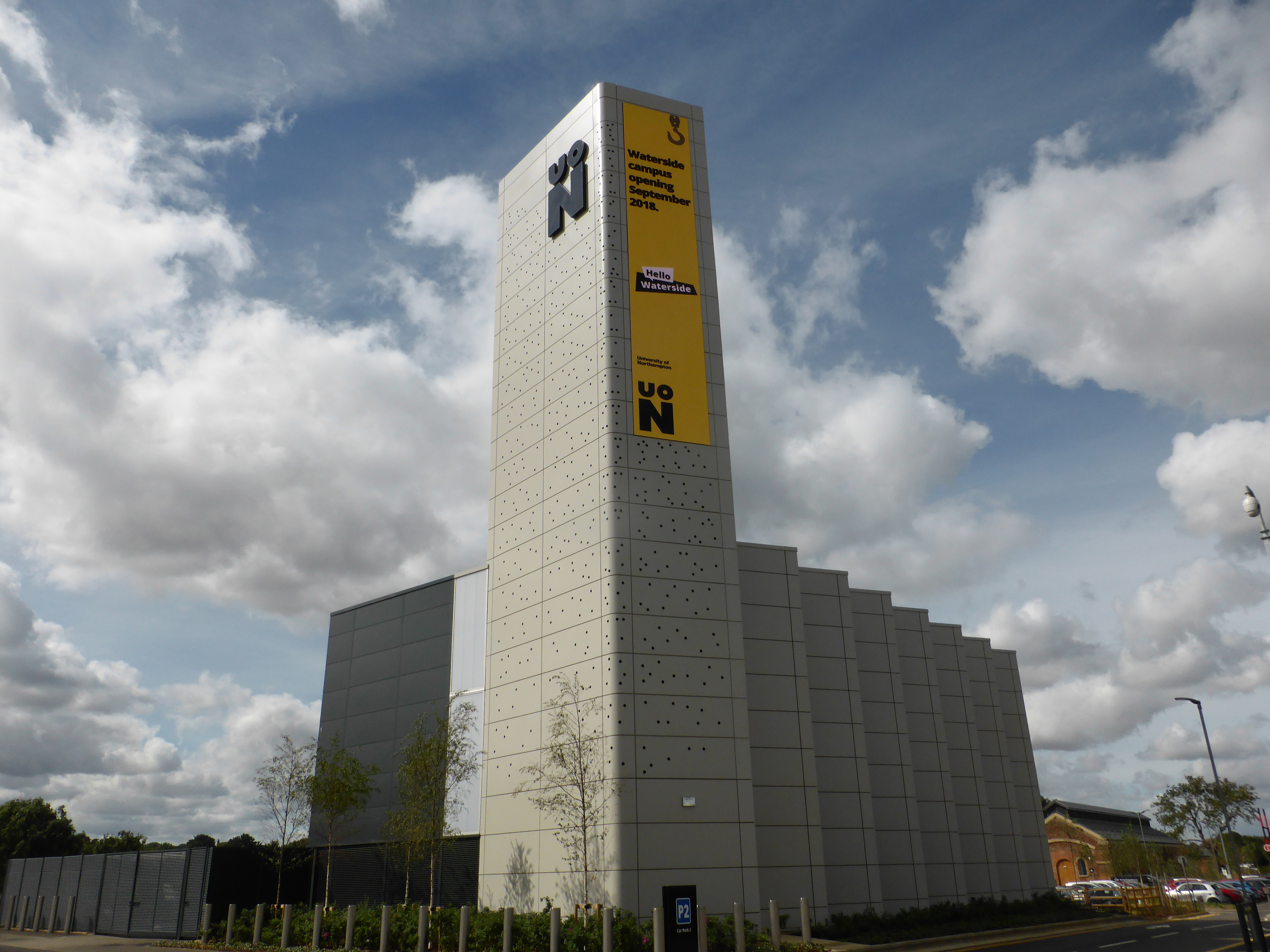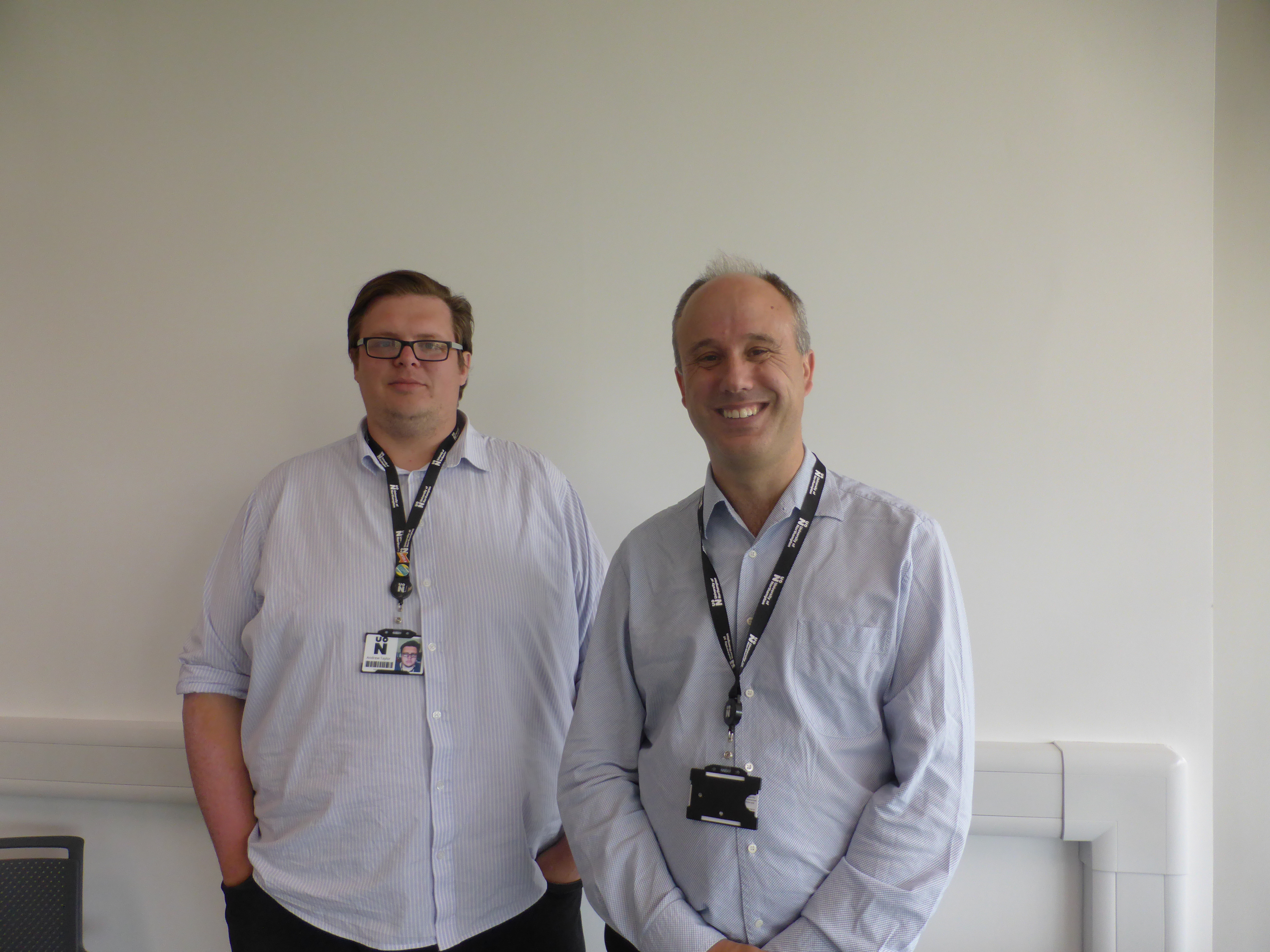
The smell of fresh paint, the site of clean carpets, boxes, workmen in high-vis and hard hats, plus the odd loose wire and empty bracket on the wall. These are all things you would expect from a brand new purpose built university campus preparing to open its doors to 15,000-plus students for the first time.
But for the University of Northampton (UoN), that’s where all expectations and assumptions end, for this is not your typical educational environment. Six-years in the making and at a cost of more than £330 million, Northampton, a town famed for its shoe making, successful rugby team and, erm, Alan Carr, is now home to a university like no other in the UK, perhaps even – as suggested – the world.

Out with the old
Traditional large lecture theatres, projectors, lecterns, interactive whiteboards, PC’s, control panels? Not here.
“This truly is a university for the 21st century,” beamed Andrew Taylor, AV lead at the UoN. “There’s no other university in the world that’s doing what we’re doing on this scale.”
Rob Howe, head of learning technology and media added: “This truly is a once in a career opportunity.”
With the UoN being built from the ground-up, the IT/AV teams were involved from the beginning (2012), working side-by-side with the architects on the original design before the first spade broke ground.
“I was involved in the initial specifications for the tender process and the eventual selection of some of the key teaching room software,” explained Howe, entering his 25th year at the UoN and also former student.
“We’re in an enviable where we’ve been able to build a campus and factor in all the lessons we have learnt over many years of what we liked, didn’t like and what works best.”
Taylor adds: “The AV and the IT were not an afterthought once the builders were finished. Having a blank canvas has allowed us to specify so much of the infrastructure that we wouldn’t normally get a say in. Cable routes, wall construction etc. This all means we don’t have the traditional issues associated with a big build, which normally means having to compromise our designs to fit buildings. We’ve been able to mould them around us. It’s allowed us to specify technologies and standards which should make, maintenance and refresh a lot easier in the long run.
He added: “We’re in a privileged position where everything here is brand new and had the opportunity to rewrite the rules on how students are taught.”
Revolution
Walking around the campus, with the almost ironic smell of freshly brewed beer in the air drifting from its neighbours Carlsberg, Taylor and Howe’s comments are hard to dismiss as typical PR. It feels different.
Passing through the main entrance (Senate Building), it was immediately evident the UoN has adopted a fresh – dare we say – revolutionary approach to how a university or indeed any educational facility is expected to function and operate.
With three main buildings in total (The Learning Hub, The Creative Hub), the university comprises of 116 ‘teaching spaces’ – not all of which are door open and shut rooms. It also has just a single lecture theatre, tiny compared to some, with just 80 seats.
The UoN has very much adopted a less is more approach to learning environments.
No boundaries
So, instead of multiple 200,300, 400-plus lecture theatres, students and tutors gather in smaller ‘spaces’ – some of which don’t even have an entrance (i.e. not an actual room) and can even house simultaneous lectures, which appear almost sporadically and unassumingly around the campus. It seems anywhere with a display and space for seating can be a place for learning, teaching and working.
These smaller spaces, both Howe and Taylor explained, are designed to help encourage collaboration between students and tutors alike, something they believe will help stimulate learning and provide a more engaging learning environment.
“We looked at what students wanted and in what environment they are able to best learn in,” explained Howe as we passed a teaching area dubbed the ‘Owls Nest’ (pictured, below)– an open area filled with tables, chairs and a display on the wall. “In my opinion, the best place to learn is not inside an enormous packed out theatre, said Taylor. “The new campus allows and encourages staff to collaborate more easily in different groups. More teaching will now happen in smaller, more personalised groups and technology will be used to allow material to be delivered more efficiently,” (more on that shortly).
Taylor, now in his tenth year at the UoN continued: “We didn’t want to think of them as rooms anymore. We wanted to think of them as spaces. Yes we still have rooms, but equally we have a lot of spaces, too.
“Students pay thousands of pounds a year to attend university, so we have to make sure we provide them with the best tools available and give them value for money. University is a business and the students are, as crude as it sounds, customers. They can’t afford to be bored or to nod off at the back of a lecture theatre and miss something important.”

New approach
The glue bringing all this together is of course through the use of AV technology – some of which has been rushed through various R&D departments to make its debut on the site.
As mentioned previously, the university does not feature many of the traditional technologies found within learning environments – and with good reason.
With smaller spaces, the need for projectors is no longer required (with the exception of the art and photography department). Taylor also noted how the previous campus (largely now demolished) had more than 50 different models of projector in use, many of which were lamp based with replacement bulb prices north of £300 a pop.
Whilst cost and green credentials are a factor (the site is going plastic packaging free, too), the reasoning behind the decision is however much greater.
Instead of projectors, it uses displays of various different sizes (all NEC) which hang from the walls – but students don’t necessarily need to be looking at them to follow what’s being discussed.
Using Barco’s WeConnect classroom solution, all content displayed during lectures is viewable on mobile devices (laptops, tablets, phones) owned and used by the students. Likewise, students are able to contribute directly with the lecture, sharing their own content – which, for obvious reasons, is green lit by the tutor in charge first.
More so, students are able to submit “silent questions” viewable to the tutor if there’s anything they are unclear on, prompting additional clarity without disrupting the flow or sounding out an individual.
“The use of Barco means that students are able to view the tutors display from their own device and also interact with the session,” said Howe. “Students don’t want barriers. They’ve come to university to learn.”
Taylor adds: “Traditional large lecture theatres aren’t built for, nor encourage collaboration. Typically, theatres are built with everyone facing forward. If you don’t understand something, you probably won’t want or won’t have the confidence to ask for a bit of extra help. That’s not an ideal environment.”

No place to hide
As a result, a key part of their strategy is to remove the traditional ‘eyes on me’ approach, with tutors now free to stand or sit wherever they choose.
Lecterns, normally housed at the front of a room or theatre – each heavily stocked with various AV controls, universal connectors, cables and equipment – are not required or present outside its one and only theatre.
Instead, tutors are each given an HP EliteBook 10301 laptop/tablet hybrid, used to control all content shown on displays, both in the room and on students devices.
“Lecterns fix the tutor at the front of the room and are sometimes used for the tutor to hide behind,” said Howe. “We wanted to provide a flexible room environment which allows the tutors to present from wherever they felt comfortable and where it was most appropriate depending on the needs of the session. Lecterns imply lecturing and this was a concept we felt could be done more effectively in a different way.
Taylor adds: “With nowhere to hide lots of switching equipment, we were forced to adopt an approach where we had a smaller in-room footprint and a larger back-end presence. This lead us down the networked AV over IP approach and also made us consider how we delivered control of the rooms.”
The wireless control approach has also removed the need for interactive whiteboards/displays – although the odd traditional pen and ink whiteboard can still be found.
“We initially were not going to put physical whiteboards in the rooms but have provided these during the transition to support tutor flexibility in their delivery of sessions,” said Howe. “Many interactive whiteboards mean the tutor faces away from their students. By putting the interactivity on the tutors device then they can directly interact with the screen from any point in the room.”
No downtime
All spaces are booked out in one hour slots throughout the day, every day during term and also in holidays.
For this, the importance of ensuring rooms are in perfect working order and that turnaround times for tutors entering the room and ready, is paramount.
To ensure set-up times are kept to a minimum, the technology is consistent throughout the university, with tutors required only to wirelessly login to the room to be ready. All rooms are also preprogrammed, with displays and lights switching on and off at specific times.
However, ensuring equipment is fully functional is something the tutor cannot foresee on entering a room at 9am shortly before the first students arrive.
“If you’re paying thousands of pounds a year to be somewhere, you don’t want your time to be wasted by having to wait around or be told the class you’re attending is cancelled,” said Taylor. “Faults are inevitable, but we had to find a way to reduce the potential impact and disruption it could cause.”
To reduce risk, the university uses Barco’s Overture software, which allows the university to closely monitor every piece of IP enabled equipment across all areas 24/7, alerting staff to any problems.
“If we know there is a problem then we know we have to fix it,” said Taylor. “If a display stops working overnight, we’ll be made aware of it immediately, know exactly where it is and can look to either fix it or replace it before anyone using the space arrives. As far as the tutor is aware, there was never a problem. That’s hugely valuable to everyone.”
Always learning
Whilst the finishing touches are put in place and the technology as they desire, both Howe and Taylor are under no illusion that everything they put together is gospel and, like the students, are also on a journey of learning – one which will undoubtedly see changes in the coming weeks, months and years.
“In six months time I can almost guarantee that what we have today will have changed in some form,” said Taylor, wrapping up. “We expect that and we’re prepared for that. Our goal is to ensure the students and tutors have what they need and we need to evolve as and when it’s required.”
Howe concluded: “We will continually evaluate the new campus and share our findings with the wider sector. We hope this will lead to better teaching and learning environments for our students and staff.”













